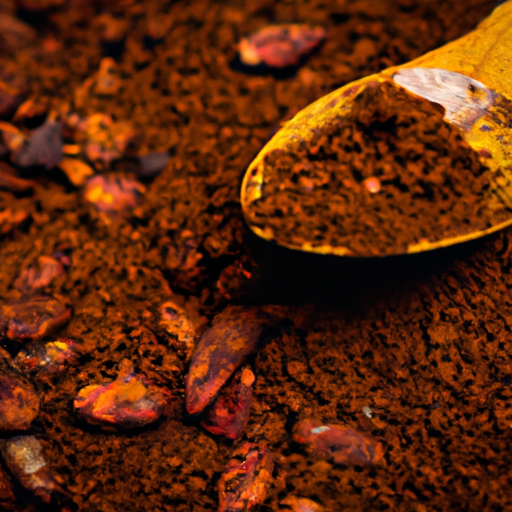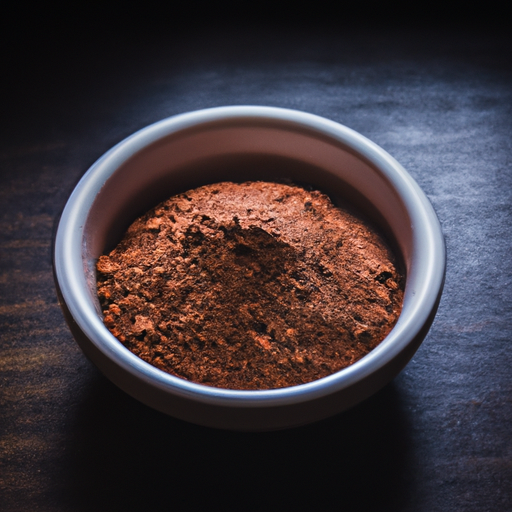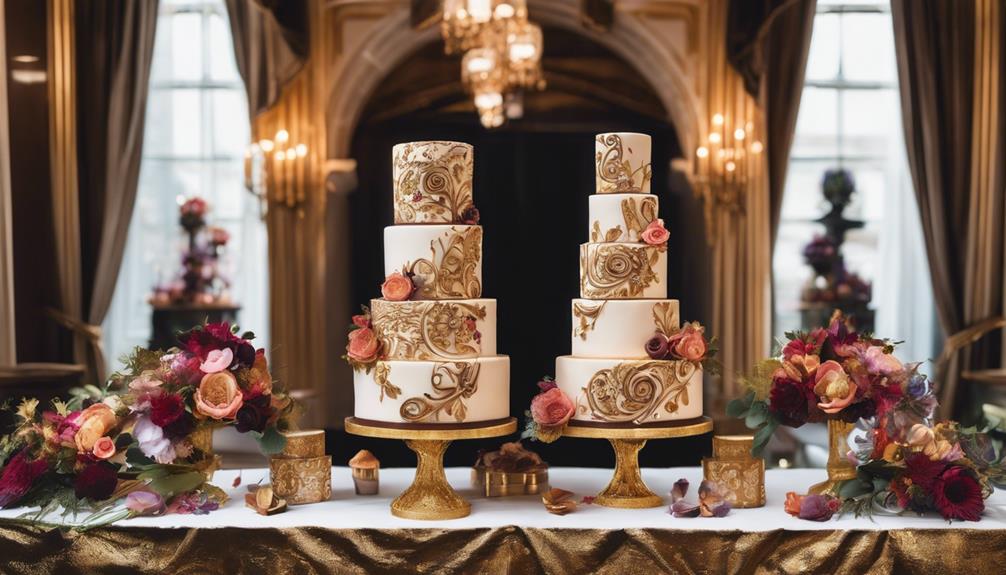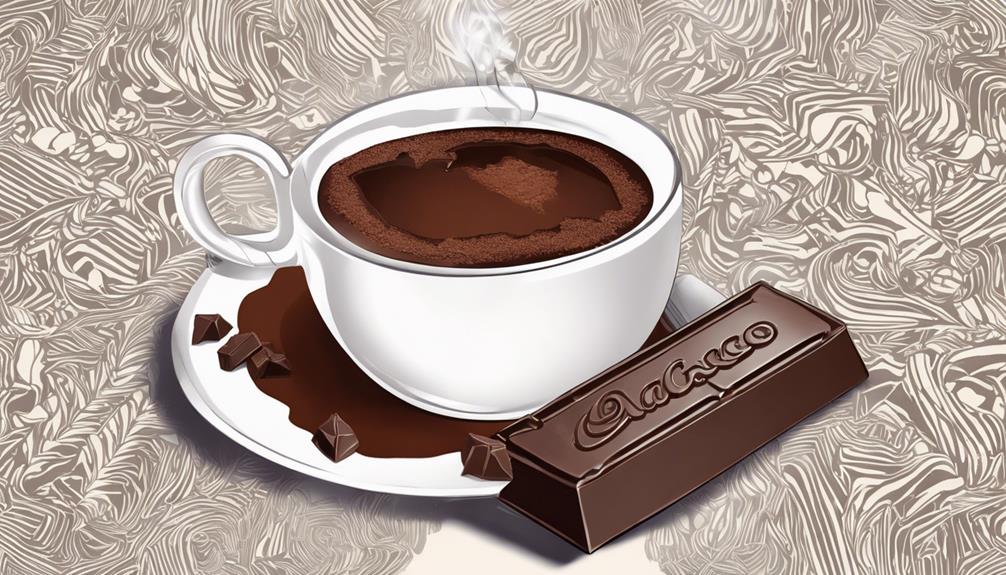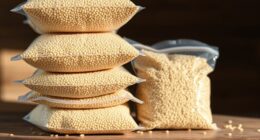Picture yourself enjoying a luxurious, smooth taste of raw cacao, with its bold flavors tantalizing your palate. But how do we achieve the ideal ratio of sweetness to enhance this luxurious delicacy? This is where monk fruit sweetener steps in.
As a lover of all things sweet, I have embarked on a quest to uncover the ideal ratio of monk fruit sweetener to raw cacao. In this article, we will dive into the world of monk fruit sweetener, understanding its nuances and determining the right level of sweetness for your raw cacao creations.
We will explore the intensity of raw cacao and how it plays a crucial role in finding the perfect balance. Moreover, I will share practical tips and considerations to ensure your sweetened raw cacao experience is nothing short of sublime.
So, let’s embark on this sweet journey and unlock the secrets to perfectly sweetened raw cacao.
Key Takeaways
- Adjust sweetness of raw cacao based on quality and origin
- Use small amounts of flavors like vanilla extract, cinnamon, or sea salt to enhance raw cacao
- Explore different sweeteners and alternatives for raw cacao, such as maple syrup, coconut sugar, and stevia
- Monk fruit sweetener is significantly sweeter than regular sugar, so use it sparingly and adjust sweetness gradually to avoid overpowering the natural flavors of raw cacao.
Understanding Monk Fruit Sweetener
You’ll love the taste of Monk Fruit Sweetener as it adds a delightful touch of sweetness to your raw cacao creations. Understanding monk fruit benefits is essential in appreciating its value as a natural sweetener.
Monk fruit, also known as Luo Han Guo, is a small, green fruit native to Southeast Asia. It contains natural compounds called mogrosides, which give it a sweet taste without adding calories or raising blood sugar levels.
Comparing monk fruit to other natural sweeteners, such as honey or maple syrup, monk fruit sweetener is a healthier alternative for those watching their sugar intake or managing diabetes. It provides a similar sweetness to sugar, but with a lower glycemic index.
Now that you understand the benefits of monk fruit sweetener, let’s move on to determining the right sweetness level for your raw cacao treats.
Determining the Right Sweetness Level
Imagine savoring a velvety, rich treat that perfectly balances the delicate flavors of nature, finding the precise level of sweetness that makes each bite a blissful escape. Determining the right sweetness level for your raw cacao recipes is essential to achieving that perfect balance. Monk fruit sweetener provides a natural and zero-calorie alternative to traditional sugar, but getting the sweetness just right requires some experimentation. Start by using the recommended serving size of monk fruit sweetener, and then adjust to taste. To help you navigate the sweetness spectrum, consider the following table:
| Sweetness Level | Amount of Monk Fruit Sweetener |
|---|---|
| Mild | 1 teaspoon |
| Medium | 2 teaspoons |
| Sweet | 3 teaspoons |
| Very Sweet | 4 teaspoons |
By adjusting the sweetness according to your preferences, you can create a customized flavor profile that complements the intensity of raw cacao. Experiment with different amounts to find the perfect balance of sweetness for your palate. Now, let’s consider the intensity of raw cacao in the next section.
Consider the Intensity of Raw Cacao
To truly appreciate the depth of flavor in your raw cacao creations, it’s important to consider the intensity of the chocolate itself. Raw cacao has a rich, robust taste that can vary in intensity depending on its origin and processing.
When using monk fruit sweetener to sweeten raw cacao, it’s crucial to balance the sweetness with the intensity of flavors present in the chocolate. The goal is to enhance the natural flavors of raw cacao without overpowering them with excessive sweetness.
By finding the right balance, you can create a harmonious blend of flavors that will satisfy your taste buds.
Now that we understand the importance of considering the intensity of raw cacao, let’s delve into the recommended ratio of monk fruit sweetener to raw cacao.
The Recommended Ratio of Monk Fruit Sweetener to Raw Cacao
Achieving the perfect balance of sweetness and flavor in your raw cacao creations is like finding the sweet spot in a delicate dance. To ensure the ideal ratio of monk fruit sweetener to raw cacao, consider the following recommendations:
-
Begin with a 1:1 ratio of monk fruit sweetener to raw cacao and adjust to taste.
-
Experiment with different monk fruit sweetener brands to find the one that best complements the rich, natural flavors of raw cacao.
-
Keep in mind the health benefits of monk fruit sweetener, which is known for being a natural, zero-calorie sweetener with no glycemic impact.
-
Remember that personal preference plays a role, so be open to adjusting the ratio to suit your taste.
By following these guidelines, you can create raw cacao treats that are both delicious and health-conscious.
Transitioning into the next section about ‘other factors to consider’, let’s explore additional elements that can enhance your raw cacao experience.
Other Factors to Consider
Now let’s delve into some other key factors that can elevate your experience with the delectable world of raw cacao.
When considering how much monk fruit sweetener to use with raw cacao, it’s important to also think about other ingredients that you may be incorporating into your recipe. For example, if you’re adding other sweeteners such as honey or maple syrup, you may need to adjust the amount of monk fruit sweetener accordingly to achieve the desired level of sweetness.
Additionally, it’s worth considering the health benefits of monk fruit sweetener. Not only does it provide a natural alternative to traditional sweeteners, but it also contains antioxidants and has a low glycemic index. These factors make monk fruit sweetener an excellent choice for those looking to enjoy the benefits of raw cacao while maintaining a balanced diet.
As we move into the next section about tips for incorporating monk fruit sweetener, you’ll discover even more ways to enhance your raw cacao creations.
Tips for Incorporating Monk Fruit Sweetener
Get ready to take your culinary creations to the next level with these helpful tips for incorporating the natural sweetness of monk fruit into your favorite recipes. When measuring monk fruit sweetener, it is important to note that it is much sweeter than sugar, so a little goes a long way. Start by using half the amount of monk fruit sweetener compared to regular sugar and adjust to taste. Remember, you can always add more if needed. One of the benefits of using monk fruit sweetener in recipes is that it has zero calories and does not raise blood sugar levels, making it a great option for those watching their calorie intake or managing diabetes. To help you visualize the conversion, refer to the table below:
| Sugar | Monk Fruit Sweetener |
|---|---|
| 1 cup | 1/2 cup |
| 1/2 cup | 1/4 cup |
| 1/4 cup | 2 tablespoons |
| 1 tablespoon | 1 1/2 teaspoons |
| 1 teaspoon | 3/4 teaspoon |
With these tips, you can easily incorporate monk fruit sweetener into your recipes and enjoy its benefits. Now, let’s move on to adjusting for personal preference.
Adjusting for Personal Preference
When it comes to adjusting the sweetness level of your recipes, it’s all about personal preference. You can easily customize the sweetness by adding more or less monk fruit sweetener to suit your taste buds.
Additionally, don’t be afraid to experiment with other flavors and ingredients to enhance the overall taste of your dishes.
And if you’re not a fan of monk fruit sweetener, feel free to try different sweeteners and alternatives to find the one that best suits your needs.
Remember, the key is to have fun and enjoy the process of creating delicious and personalized recipes.
Customizing the Sweetness Level
To achieve your desired sweetness level, you’ll need to experiment with different amounts of monk fruit sweetener when using raw cacao. Customizing sweetness is all about finding the right balance that suits your taste buds.
Start by adding a small amount of monk fruit sweetener to your raw cacao recipe, then taste and adjust as needed. Remember that monk fruit sweetener is much sweeter than regular sugar, so a little goes a long way. Gradually increase the amount until you reach your desired level of sweetness.
Keep in mind that the sweetness of raw cacao can vary depending on its quality and origin, so it’s important to taste and adjust accordingly. By experimenting with different amounts, you’ll find the perfect sweetness level that enhances the rich flavor of raw cacao.
Once you’ve achieved your desired sweetness, you can move on to adding other flavors and ingredients to further enhance your raw cacao creations.
Adding Other Flavors and Ingredients
Once you’ve achieved your desired level of sweetness, it’s time to explore a world of flavors and ingredients to elevate your raw cacao creations.
Adding additional flavors can take your treat to the next level. Consider experimenting with ingredients like vanilla extract, cinnamon, or even a pinch of sea salt to enhance the taste of your raw cacao.
Be mindful of finding the right balance when adding these flavors, as you don’t want to overpower the natural richness of the cacao. Start with small amounts and gradually increase until you achieve the desired taste. Remember, the goal is to complement the raw cacao, not overpower it.
By adding these additional flavors, you can create a truly unique and delicious treat.
Now, let’s explore the next step – trying different sweeteners and alternatives.
Trying Different Sweeteners and Alternatives
Exploring alternative sweeteners can be like discovering a hidden treasure chest of flavors, each one unlocking unique depths of taste and satisfaction. When it comes to sweetening raw cacao, I’ve found that trying different options can lead to surprising and delicious results.
Here are three alternative sweeteners to consider:
-
Maple syrup: This natural sweetener adds a rich, caramel-like flavor that pairs beautifully with the bitterness of raw cacao.
-
Coconut sugar: Made from the sap of coconut palm trees, coconut sugar offers a subtle sweetness and a hint of nuttiness that complements the earthiness of raw cacao.
-
Stevia: Derived from the stevia plant, stevia is a calorie-free sweetener that can be up to 300 times sweeter than sugar. It’s a great option for those looking to reduce their sugar intake.
By exploring alternative sweeteners like maple syrup and stevia, you can find the perfect balance of sweetness for your raw cacao creations.
Now, let’s delve into the next section about storing and shelf life of monk fruit sweetener.
Storing and Shelf Life of Monk Fruit Sweetener
When storing monk fruit sweetener, be sure to keep it in an airtight container to maintain its freshness and extend its shelf life. This is important because exposure to air and moisture can cause the sweetener to clump and lose its natural sweetness over time.
By sealing it tightly, you can prevent any moisture or contaminants from entering the container and affecting the quality of the sweetener. It is also recommended to store monk fruit sweetener in a cool, dry place away from direct sunlight, as heat and light can degrade its flavor and potency.
Following these storage guidelines will help you enjoy the perfectly sweetened raw cacao without compromising the quality of your monk fruit sweetener.
Conclusion: Enjoying the Perfectly Sweetened Raw Cacao
To fully savor the indulgent delight of your favorite chocolate treat, relish every bite of the exquisitely sweetened raw cacao.
Finding the perfect sweetness level for your raw cacao can enhance your enjoyment of this decadent treat. When using monk fruit sweetener, it’s important to start with a small amount and gradually increase it to achieve the desired sweetness. Monk fruit sweetener is significantly sweeter than regular sugar, so a little goes a long way.
Experimentation is key to finding the right balance of sweetness that suits your taste buds. Remember that raw cacao has its own inherent bitterness, so adding too much sweetener can overpower its natural flavors.
By carefully adjusting the amount of monk fruit sweetener, you can create a perfectly sweetened raw cacao that will satisfy your cravings and bring you pure chocolate bliss.
Frequently Asked Questions
Can monk fruit sweetener be used as a substitute for other sweeteners in recipes?
Using monk fruit sweetener as a substitute in recipes is a great choice. It adds sweetness without the extra calories or sugar. It’s perfect for beverages and can aid in weight loss due to its low glycemic index.
Can monk fruit sweetener be used in baking recipes that require high heat?
Using monk fruit sweetener in baking recipes can be a great alternative to traditional sweeteners. However, it is important to note that monk fruit sweetener may not caramelize or brown like sugar does in high heat baking.
Is monk fruit sweetener safe for individuals with diabetes or those following a low-carb diet?
Monk fruit sweetener is safe for individuals with diabetes or those following a low-carb diet. It has a low glycemic index impact, making it a suitable option. Additionally, it can be beneficial for weight management.
How does the taste of monk fruit sweetener compare to traditional sugar or other natural sweeteners?
Monk fruit sweetener has a taste similar to traditional sugar, without the calories or impact on blood sugar levels. Compared to other natural sweeteners, it provides a healthier alternative. It’s great for beverages due to its ability to enhance flavor without adding extra carbs.
Are there any potential side effects or health concerns associated with consuming monk fruit sweetener?
There are no known long-term effects or significant risks associated with consuming monk fruit sweetener. However, it’s always important to consume any sweetener in moderation as part of a balanced diet.
How to Use Monk Fruit Sweetener with Raw Cacao Powder to Achieve Euphoria?
To achieve euphoria, combine monk fruit sweetener with raw cacao powder. The raw cacao powder benefits include enhancing mood and promoting feelings of happiness. Mix the two ingredients into a smoothie or sprinkle them over yogurt to experience the blissful effects of this natural combination.
Conclusion
In conclusion, finding the right amount of monk fruit sweetener for raw cacao is all about understanding your personal preference and considering the intensity of the cacao.
While some may argue that using a sweetener takes away from the natural taste of raw cacao, incorporating monk fruit sweetener can actually enhance the overall flavor and sweetness.
By following the recommended ratio and adjusting to taste, you can enjoy the perfect balance of sweetness in your raw cacao creations.
So go ahead, indulge in the delicious world of monk fruit sweetened raw cacao!

